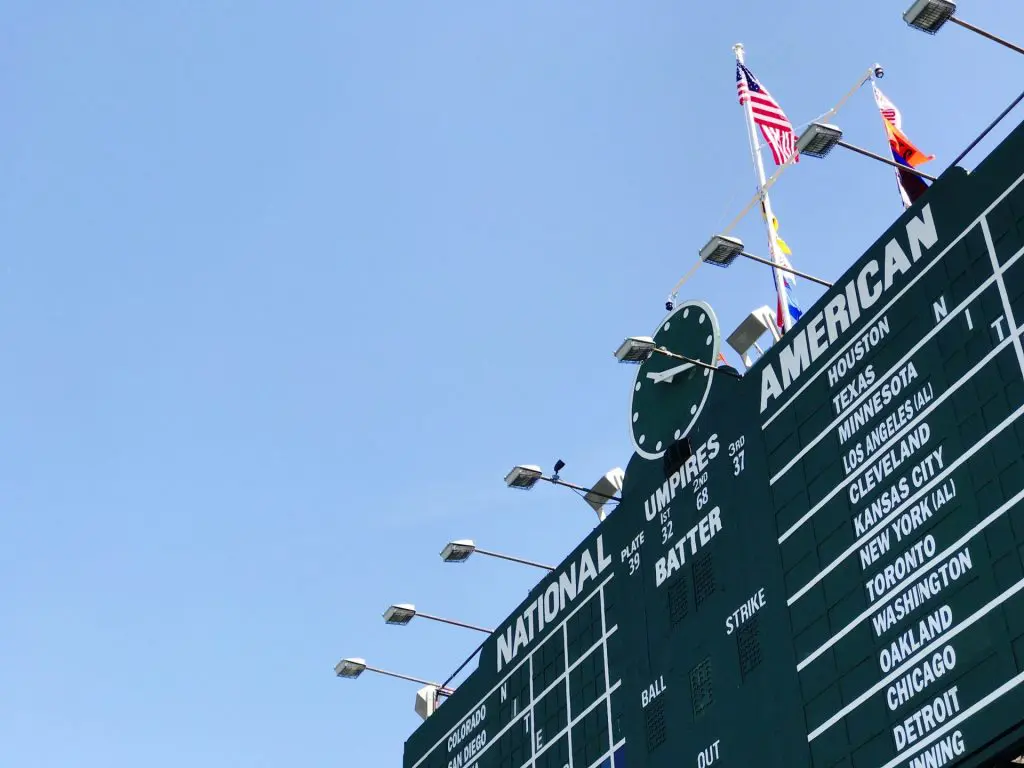What Does OPS Mean in Baseball?
Baseball, perhaps more than just about any other sport, utilizes a deep number of analytics, statistics, and probabilities to better understand and measure in-game activity. In fact, baseball utilizes empirical analysis so often, an entire word was coined to describe the term – Sabermetrics.
And while baseball analytics has been recently more popularized by the hit movie Moneyball, baseball and empirical analysis have been around since 1858, with the development of the box score by Henry Chadwick.
Yet, one analytical baseball term which seems to confuse even the most ardent baseball fan is OPS. Below, we are going to fully discuss and review what OPS means in baseball, whether or not it is a good analytical measurement, and what alternatives there are to use to measure a hitter’s ability to reach base.

What Does OPS Stand For?
In baseball, OPS stands for on-base plus slugging. However, OPS is not an independent variable. Meaning that in order to quantify a players OPS, we must utilize two additional statistics. To get OPS, you will need to know a players OBP and their SLG.
By adding an individual baseball players OBP and SLG, we are able to determine their OPS.
OBP + SLG = OPS
On-Base Percentage (OBP)
In baseball, an on-base percentage refers to the frequency with which a batter is able to reach a base per appearance at the plate. And while, one would assume, that the ability to reach a base is done via a hit, on-base percentage includes a batter’s walks and hit-by-pitches.
However, notably, on-base percentage does not include errors, times reached on a fielder’s choice, dropped third strikes, and sacrificial bunts.
On-base percentage attempts to quantify a hitter’s ability to avoid making an out and the OBP shows which hitter’s are best able to accomplish that task.
Slugging Percentage (SLG)
In baseball, a slugging percentage or SLG, looks to record the total number of bases a hitter records per at-bat. And, unlike on-base percentage, the slugging percentage deals only with hits and does not take into consideration walks and hit-by-pitches into its calculation.
Slugging percentage is more useful in being able to determine a hitter’s strength and power, particularly because it is able to account for more than just home runs.
And while slugging percentage is often confused with batting average, the two represent different statistical values. Whereas batting averaged is calculated by dividing the total number of hits by the total number of at-bats, slugging percentage looks to provide higher values for the total number of bases a player records per at-bat.
This means that a hitter who is able to reach second, third, and the home base will have a higher slugging percentage than a hitter who only reaches first base.
To calculate a slugging percentage, follow this simple formula: (1B + 2Bx2 + 3Bx3 + HRx4)/AB.

Why is OPS Valuable?
While there are a number of well-known and more accurate determinations for a hitter’s ability, OPS stands out as the single easiest stat to calculate. As both the on-base percentage and slugging percentage are widely known, calculating the value of OPS is simple and straightforward.
Understanding that a players ability to get on base, via OBP, is a valuable metric and their ability to hit the ball further and reach further bases, via SLG, is also a valuable metric, it logically follows that by combining the two you can receive a rough estimate on how valuable a player is when at the plate.
Similarly, OPS is a good stat simply because it has a much stronger correlation with runs scored than either OBP or SLG.
In addition, due to the relative ease in calculating OPS, it is particularly useful for quick, back of a napkin stats that can show the relative strength of an offensive player in baseball. That is, because it is so easy to calculate, it is one of the better stats for a quick overview of offensive baseball players.

Example OPS Formula
Once you’ve understood what OPS stands for and what it is, it’s good to practice a bit to have a better, more thorough understanding of the stat. Again, OPS is calculated very simply by adding the percentages of OBP and SLG, so no difficult math skills are needed here.
Player A (Average Player)
Player A plays for the New York Yankees. He has an on-base percentage (OBP) of .322, which is an average on-base percentage, and a slugging percentage (SLG) of .435, which also happens to be an average slugging percentage. To get Player A’s OPS, we simply add his OBP and his SLG. So, in this theoretical example, we would add .322 (OBP) with .435 (SLG), for a final result, and an OPS, of .757, which falls in line with the average baseball player.
Player B (Excellent Player)
Player B also plays for the New York Yankees. However, unlike Player A, Player B has an on-base percentage (OBP) of .465, which happens to be a very good on-base percentage. Similarly, the same player has a slugging percentage (SLG) of .550, which also happens to be a very good slugging percentage. So, to get Player B’s OPS, we simply add his OBP and his SLG. In this example, we would add .465 (OBP) with .550 (SLG), for a final result, and an OPS, of 1.015, which falls in line with that of an excellent player.
Player C (Below Average Player)
Player C also plays for the New York Yankees. However, unlike Player A or Player B, Player C is a below average player. He currently has an on-base percentage (OBP) of .290, which happens to be a poor on-base percentage. Similarly, Player C has a slugging percentage (SLG) of .383, which happens to be a poor slugging percentage. So, to get Player C’s OPS, we simply add his OBP and his SLG. In this example, we would add .290 (OBP) with .383 (SLG), for a final result, and an OPS, of .673, which falls in line with that of a poor player.

What is a Good and Bad OPS?
Determining a good or bad OPS can be a bit difficult as there are a plethora of additional factors which go into a players overall effectiveness as an offensive player. However, in that OPS is a simple stat and is meant to be understood as a baseline, so too should its outcome.
Generally, we like to calculate a good or bad OPS as we would with grades in school. An OPS of .900 an above is an A and reserved for the most excellent players, an OPS of .800-.899 is a B and is good but not elite, an OPS of .700-.799 is a C and is average and neither good not bad, and any OPS of a .699 or below a D and is considered poor.
| OPS Percentage | Ranking | School Grade Equivalent |
| OPS > .900 | Elite Player | A |
| .899 > OPS > .800 | Good Player | B |
| .799 > OPS > .700 | Average Player | C |
| .699 > OPS | Poor Player | F |

Best OPS Percentages in the MLB of All-Time
Understanding and calculating an OPS is relatively simple once you have both the OBP and SLG percentages. However, it is always interesting to see what some of the best OPS percentages of all-time are and how some modern players stack up against the greatest baseball players of all time.
| MLB Player | OPS % | Year |
| Barry Bonds | 1.421 | 2004 |
| Barry Bonds | 1.381 | 2002 |
| Babe Ruth | 1.379 | 1920 |
| Barry Bonds | 1.378 | 2001 |
| Babe Ruth | 1.359 | 1921 |
| Babe Ruth | 1.309 | 1923 |
| Ted Williams | 1.287 | 1941 |
| Barry Bonds | 1.278 | 2003 |
| Babe Ruth | 1.258 | 1927 |
| Ted Williams | 1.257 | 1957 |
| Babe Ruth | 1.253 | 1926 |
| Babe Ruth | 1.252 | 1924 |
| Rogers Hornsby | 1.245 | 1925 |
| Lou Gehrig | 1.240 | 1927 |
| Babe Ruth | 1.225 | 1930 |
| Mark McGwire | 1.222 | 1998 |
| Jimmie Foxx | 1.218 | 1932 |
| Frank Thomas | 1.217 | 1994 |
| Rogers Hornsby | 1.203 | 1924 |
| Jeff Bagwell | 1.201 | 1994 |

Is OPS Increasing Year-Over-Year?
Interestingly, taking a look at Baseball Reference, we can see that the OPS stat is generally stable and has not veered too far from the mean. And although, in the past two decades, the OPS percentage is increasing ever so slightly, the overall percentage remains within the .710 range.
What Are the Best OPS Stats by Player by Year?
For the truly exceptional players, their OPS stats remain in the high .900 and even cross over above 1.000. Such stats are truly amazing and are generally reserved for only the elite and most exceptional players in the league.
You can find a full list of the top MLB players OPS by year and division here.

What is OPS+?
Due to the MLB’s differentiating factors, including weather, stadium, and stadium size, not all OPS are created equally, with players playing in smaller stadiums which allow for more home runs having a higher OPS.
Therefore, many people like to utilize OPS+ or adjusted OPS. OPS+ is adjusted for the park and the league in which the player played and an OPS+ of 100 is so defined as the overall league average. Therefore, an OPS+ of 150 indicates that a player outperformed 50% of his peers during that particular season.
The calculation for OPS+ is generally more difficult and is typically done by professional statisticians and Sabermetricians. However, if interested, the formula to calculate OPS+ is as follows:
In this formula, *lgOBP is the park adjusted OBP of the league and *lgSLG is the park adjusted SLG of the league.

What is a Better Calculation Than OPS or OPS+?
Whereas OPS is a great calculation to understand a players offensive abilities quickly, and OPS+ looks to remove external variable, a far better calculation is wOBA. wOBA, or weighted on-base average, was created by Tom Tango and looks to measure a hitter’s overall offensive value, based on the relative values of each distinct offensive event.
wOBA is a rate statistic which attempts to credit a hitter for the value of each outcome, rather than treating each hit or times on base equally. A far better measure than either OPS or OPS+, wOBA is significantly more difficult to calculate and therefore many fans will simply stick with the OPS value, which generally arrives at the same conclusion.
